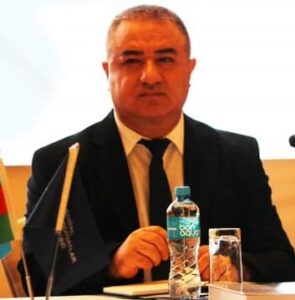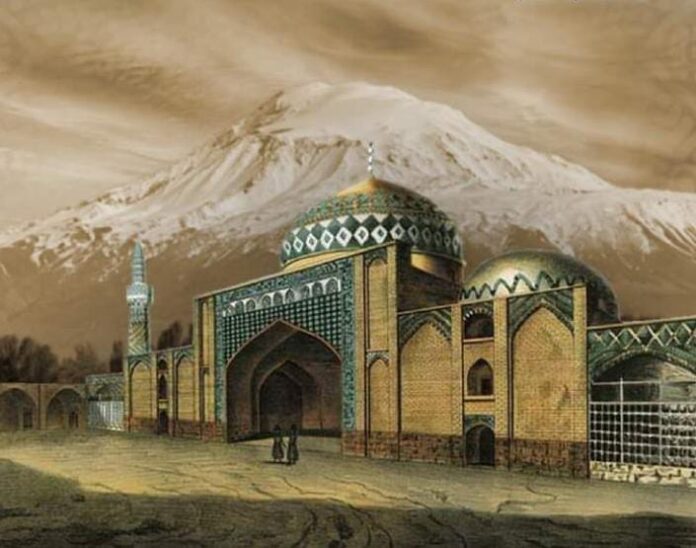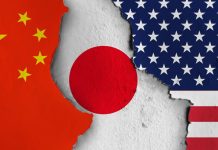By Dr. Afgan Valiyev
What do we know about Azerbaijanis in the territory of present-day Armenia BC? We know that they began to live in the 2nd century. The territory of Western Azerbaijan, which is the historical land of Azerbaijan, was a part of the ancient state of Albania until the IV century BC.
During the rule of Albania, temples, castles, palaces and examples of material and cultural heritage of various origins were built in the area. During the Arab caliphate in the 8th-9th centuries, mosques were built in Western Azerbaijan, and Islamic religion and culture spread. This has also affected the customs and living conditions of the population. During the Seljuk state in the XI-XIII centuries, the region gained more importance as a political and strategic center. During the Great Mongol Empire in the 13th and 14th centuries, the area was more destroyed and invaded.
Western Azerbaijan developed during the period when it was part of the Garagoyunlu state in 1410-1468, Aggoyunlu state in 1468-1501, and Safavid state in 1501-1736. Palaces, mosques, caravansaries, bridges were built[i] Western Azerbaijan has been an ancient homeland inhabited by Azerbaijanis for hundreds of years. In all historical periods, Azerbaijanis have taken place as the main aborigine nation in the ethnic composition of the population of Iravan.
However, at the end of the 19th century and the beginning of the 20th century, the Kurakchay Treaty (1805) signed between the Karabakh Khanate and Russia with the support of the great powers with political interests in the region, the Gulustan (1813) and Turkmenchay (1828) treaties concluded between Russia and Iran, and later between Türkiye and Iran After the Edirne (1829) peace agreements, the policy of mass resettlement of Armenians to the lands of Azerbaijan was implemented.
Deportation and genocide of Azerbaijanis living in Iravan, Goycha, Zangezur and Zangibasar region from their historical homeland was started in order to implement the policy of Armenianization of the region. With the transfer of Armenians from Iran and Türkiye to these areas, the ethnic composition of the population changed. It was founded on May 28, 1918 by the Dashnaks in the territory of the former Iravan Khanate, which is the territory of ancient Azerbaijan. On July 7, 1923, the Nagorno-Karabakh Autonomous Province was established by artificially granting the right to autonomy to the Armenians who were transferred from Iran and the territory of the Ottoman Empire to the territory of the Karabakh Khanate.
In the first years of the Soviet rule, a part of the Zangezur district was given to Armenia, and the land of Nakhchivan was separated from Azerbaijan, and Türkiye from the Turkic world. After settling in the territories belonging to Azerbaijanis, the new Armenians who usurped the Oghuz homeland of our ancestors with the support of the great powers tried to erase their traces by destroying the material and cultural samples belonging to them, and if this was not possible, it was a false history that those material and cultural samples belonged to “ancient Armenians” they started deceiving the world community by writing.
Armenian historians themselves confirm that Armenians are not autochthonous inhabitants of the current territory of Armenia. Vardan Parsamyan shows that in 1828-1830, approximately 140,000 Armenians were relocated from Iran and the Ottoman Empire and settled mainly in the territories of the Iravan and Nakhchivan khanates[ii]. In 1905-1907, 1918-1920, 1948-1953, 1959-1979, 1987-1991, the policy of ethnic cleansing of Azerbaijanis from those territories was implemented with the aim of creating a “mono-ethnic Armenia” state.
On December 27, 1947, the Council of Ministers of the USSR adopted decision No. 4083 “On the transfer of collective farmers and other population from the Armenian SSR to the Kur-Araz plain of the Azerbaijan SSR”. With this decision, 144,654 Azerbaijanis were forcibly relocated from Armenia to Azerbaijan in 1948-1953[iii]. In 1989, the USSR government expressed its opinion on the decision “On the transfer of collective farmers and other Azerbaijani population from the Armenian SSR to the Kur-Araz lowland of the Azerbaijan SSR” and adopted a decision to restore the rights of the peoples who were deported in the 1940s, but in 1948-1953 Azerbaijanis deported from Armenia were not included in the list of those nations[iv].
During the last deportations that took place in 1987-1991, more than 300,000 Azerbaijanis from 22 regions (172 purely Azerbaijani, 40,928 families from mixed settlements with Armenians) were forcibly removed from their ancestral homes. It is shown that in 1987-1991, Azerbaijanis were evicted from the 8,000 sq.km settlement where Azerbaijanis lived in Armenia for centuries, and 216 Azerbaijanis (including 57 women and 23 children) were killed. Regarding the case of 203 people who were tortured and killed, it is known from the materials sent to the prosecutor’s office of the USSR and the investigative bodies of Azerbaijan that 14 people were killed by firearms, 45 people were beaten, 13 people were burned, and 131 people were killed by various tortures.
As a result of the transfer of Armenians to the historical lands of Azerbaijan, the ethnic composition of the population in the region has changed, and the Caucasus region has become a source of unrest and conflict. Genocide, deportation, as well as the destruction of settlements, historical and cultural monuments belonging to our compatriots, changing the historical names of material and cultural samples belonging to Azerbaijanis, attempts to erase the traces of Azerbaijanis in the region by subjecting them to Armenianization, and if this is not possible, the destruction of those material and cultural monuments, or cases such as preparing fake documents about “belonging to ancient Armenians” were part of their hateful policy.
Starting from 1918-1991, 234 schools, 214 libraries, 268 cultural institutions, 235 health centers, 112 kindergartens, and 152 household houses were occupied by Armenians in the territories that Azerbaijanis were forced to leave in Western Azerbaijan. 223 cemeteries, 500 Albanian temples, 630 mosques, 150 pyres/hearths/shrines, 4500 tombstones, 200 tombs, 120 caravanserais and thousands of historical-architectural monuments were gradually vandalized.
In general, more than 10,000 historical, religious and material-cultural monuments were consciously and plannedly destroyed and appropriated by the Armenians. At present, only the Blue Mosque in Yerevan and several mosques in the regions have partially survived in the territory of Armenia – Yerevan, which, after structural changes, have been partially preserved. It is presented as a (Iranian) mosque. Racism and hatred are at the root of this destructive activity.
After the Armenian leadership finished the “cleansing action of Azerbaijanis”, they started the next and final stage of changing the names of the villages where they live. By the decree of the Supreme Soviet of the Republic of Armenia dated April 9, 1991, the names of 90 settlements were changed. This can be considered a continuation of the “name change operation” carried out in Armenia during the years 1920-1987. Only from 1920 to 1991, 650 Azerbaijani settlements in Armenia were renamed. The name change operation is still ongoing.
[i] [i] World Azerbaijanis: History and Modernity. Baku, 2009, p. 146
[ii] (Vardan Parsamyan, History of the Armenian people 1801-1900, Hayastan Publishing House, Yerevan 1972, p. 68).
[iii] Sardarov Z. “The greatest historical injustice” article. “Khalq newspaper”, December 26, 1997
[iv] Z. Sardarov, “The greatest historical injustice”, “Xalq newspaper”, December 26, 1997.
 Author:Dr. Afgan Valiyev,Doctor of Philosophy in Sociology, Head of Department of the Social Research Center, Member of the Council of Intellectuals of West Azerbaijan.
Author:Dr. Afgan Valiyev,Doctor of Philosophy in Sociology, Head of Department of the Social Research Center, Member of the Council of Intellectuals of West Azerbaijan.






